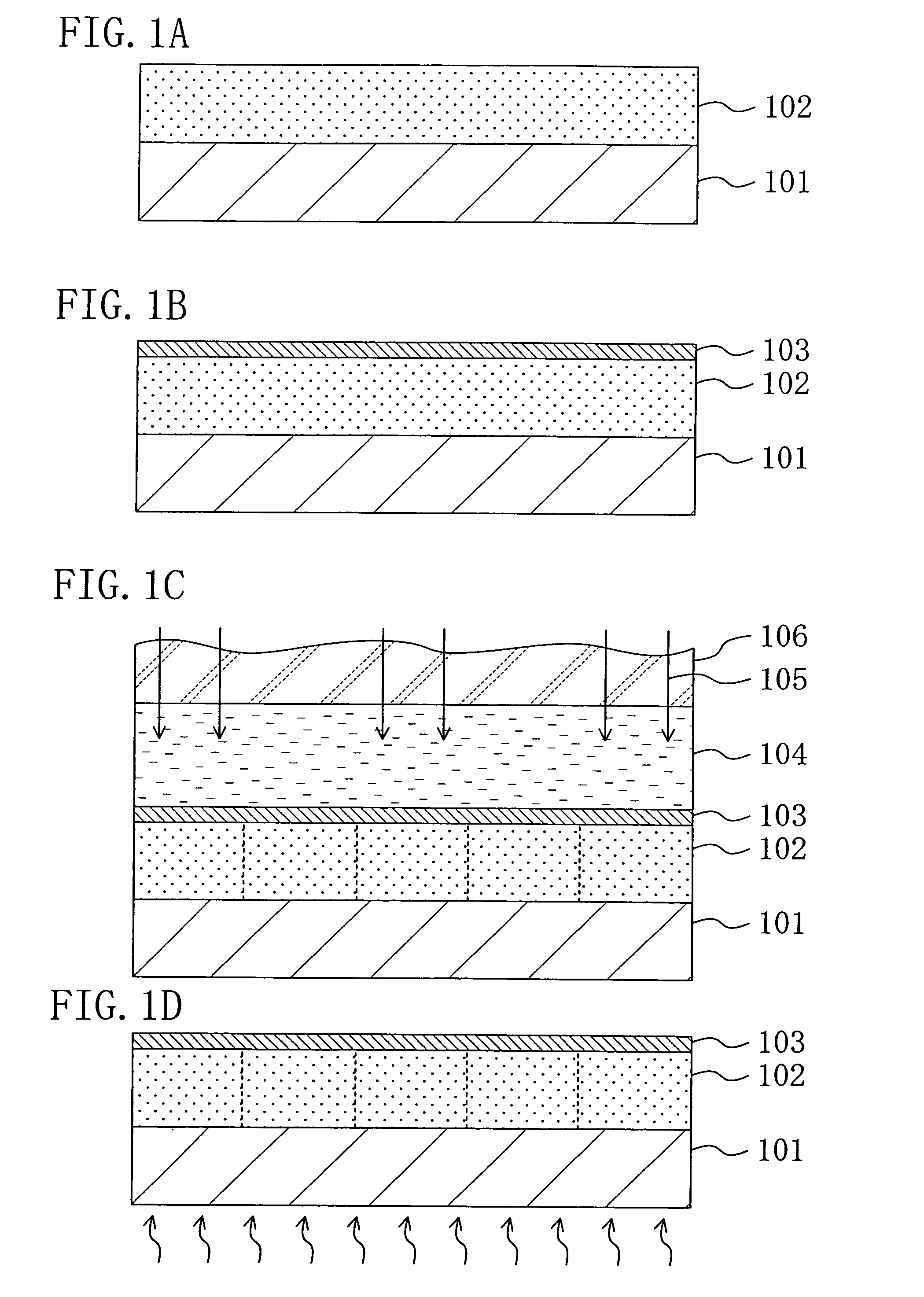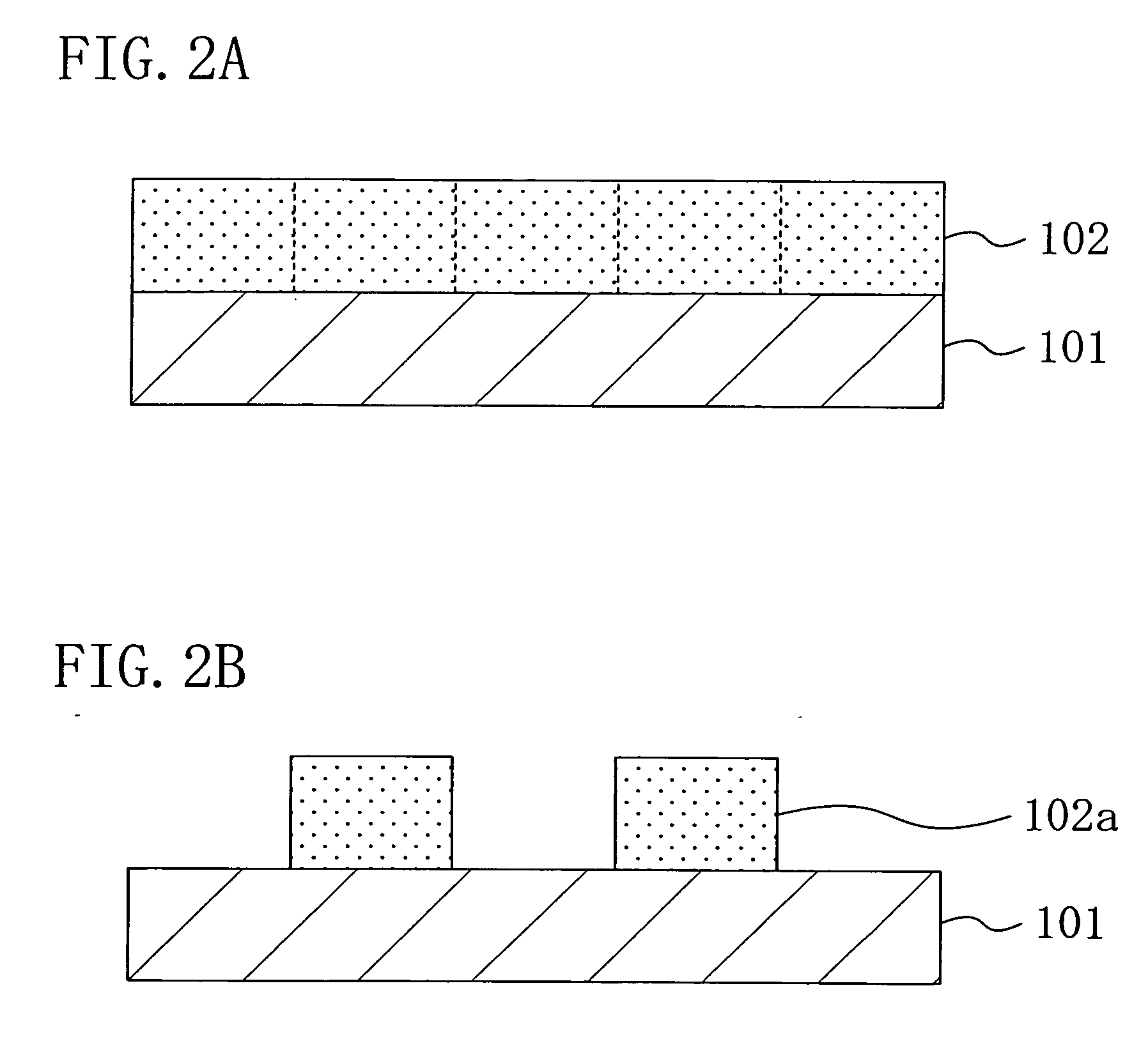Barrier film material and pattern formation method using the same
a barrier film and pattern formation technology, applied in the direction of photomechanical equipment, instruments, photosensitive material processing, etc., can solve the problems of low productivity and yield in the fabrication process of semiconductor devices, and achieve the effect of improving the dissolution characteristic of resists and good shap
- Summary
- Abstract
- Description
- Claims
- Application Information
AI Technical Summary
Benefits of technology
Problems solved by technology
Method used
Image
Examples
embodiment 1
[0062] A pattern formation method using a barrier film material according to Embodiment 1 of the invention will now be described with reference to FIGS. 1A through 1D, 2A and 2B.
[0063] First, a positive chemically amplified resist material having the following composition is prepared:
Base polymer: poly((norbornene-5-methylene-t-2gbutylcarboxylate) (50 mol %) - (maleic anhydride)(50 mol %))Acid generator: triphenylsulfonium triflate0.06gQuencher: triethanolamine0.002gSolvent: propylene glycol monomethyl ether acetate20g
[0064] Next, as shown in FIG. 1A, the aforementioned chemically amplified resist material is applied on a substrate 101 so as to form a resist film 102 with a thickness of 0.35 μm.
[0065] Then, as shown in FIG. 1B, by using a water-soluble barrier film material having the following composition, a barrier film 103 having a thickness of 0.07 μm and including dicyclohexylamine, that is, a basic compound, is formed on the resist film 102 by, for example, spin coating: ...
embodiment 2
[0071] A pattern formation method using a barrier film material according to Embodiment 2 of the invention will now be described with reference to FIGS. 3A through 3D and 4A through 4C.
[0072] First, a positive chemically amplified resist material having the following composition is prepared:
Base polymer: poly((norbornene-5-methylene-t-2gbutylcarboxylate) (50 mol %) - (maleic anhydride)(50 mol %))Acid generator: triphenylsulfonium triflate0.06gQuencher: triethanolamine0.002gSolvent: propylene glycol monomethyl ether acetate20g
[0073] Next, as shown in FIG. 3A, the aforementioned chemically amplified resist material is applied on a substrate 201 so as to form a resist film 202 with a thickness of 0.35 μm.
[0074] Then, as shown in FIG. 3B, by using a water-soluble barrier film material having the following composition, a barrier film 203 having a thickness of 0.07 μm and including tricyclopentylamine, that is, a basic compound, is formed on the resist film 202 by, for example, the sp...
embodiment 3
[0082] A pattern formation method using a barrier film material according to Embodiment 3 of the invention will now be described with reference to FIGS. 5A through 5D and 6.
[0083] First, a positive chemically amplified resist material having the following composition is prepared:
Base polymer: poly((norbornene-5-methylene-t-2gbutylcarboxylate) (50 mol %) - (maleic anhydride)(50 mol %))Acid generator: triphenylsulfonium triflate0.06gQuencher: triethanolamine0.002gSolvent: propylene glycol monomethyl ether acetate20g
[0084] Next, as shown in FIG. 5A, the aforementioned chemically amplified resist material is applied on a substrate 301 so as to form a resist film 302 with a thickness of 0.35 μm.
[0085] Then, as shown in FIG. 5B, by using a water-soluble barrier film material having the following composition, a barrier film 303 having a thickness of 0.09 μm and including tricyclohexylamine, that is, a basic compound, is formed on the resist film 302 by, for example, the spin coating: ...
PUM
 Login to View More
Login to View More Abstract
Description
Claims
Application Information
 Login to View More
Login to View More - R&D
- Intellectual Property
- Life Sciences
- Materials
- Tech Scout
- Unparalleled Data Quality
- Higher Quality Content
- 60% Fewer Hallucinations
Browse by: Latest US Patents, China's latest patents, Technical Efficacy Thesaurus, Application Domain, Technology Topic, Popular Technical Reports.
© 2025 PatSnap. All rights reserved.Legal|Privacy policy|Modern Slavery Act Transparency Statement|Sitemap|About US| Contact US: help@patsnap.com



